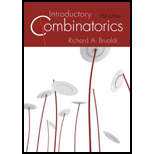Solutions for Introductory Combinatorics
Problem 2E:
Determine each of the 11 nonisomorphic graphs of order 4, and give a planar representation of...Problem 4E:
Does there exist a graph of order 5 whose degree sequence equals (4, 4, 4, 2, 2)? a multigraph?
Problem 5E:
Use the pigeonhole principle to prove that f1 graph of order n ≥ 2 always has two vertices of the...Problem 7E:
Let be a sequence of n nonnegative integers whose sum is even. Prove that there exists a general...Problem 8E:
Let G be a graph with degree sequence (d1, d2, ..., dn). Prove that, for each k with 0 < k < n,
Problem 10E:
Prove that any two connected graphs of order n with degree sequence (2, 2, ..., 2) are isomorphic.
Problem 11E:
Determine which pairs of the general graphs in Figure 11.39 are isomorphic and, if isomorphic, find...Problem 12E:
Determine which pairs of the graphs in Figure 11.40 are isomorphic, and for those that are...Problem 13E:
Prove that, if two vertices of a general graph are joined by a walk, then they are joined by a...Problem 14E:
Let x and y be vertices of a general graph, and suppose that there is a closed walk containing both...Problem 15E:
Let x and y be vertices of a general graph, and suppose that there is a closed trail containing both...Problem 16E:
Let G be a connected graph of order 6 with degree sequence (2, 2, 2, 2, 2, 2).
Determine all the...Problem 18E:
Let γ be a trail joining vertices x and y in a general graph. Prove that the edges of γ can be...Problem 19E:
Let G be a general graph and let G' be the graph obtained from G by deleting all loops and all but...Problem 20E:
Prove that a graph of order n with at least
edges must be connected. Give an example of a...Problem 29E:
Determine if the multigraphs in Figure 11.41 have Eulerian trails (closed or open). In case there is...Problem 34E:
Determine all nonisomorphic graphs of order at most 6 that have a closed Eulerian trail.
Problem 39E:
Call a graph cubic if each vertex has degree equal to 3. The complete graph K4 is the smallest...Problem 40E:
* Let G be a graph of order n having at least
edges. Prove that G has a Hamilton cycle. Exhibit a...Problem 41E:
Let be an integer. Let Gn be the graph whose vertices are the n! permutations of , wherein two...Problem 42E:
Prove Theorem 11.3.4.
Problem 46E:
Prove that Km,n is isomorphic to Kn,m.
Problem 48E:
Is GraphBuster a bipartite graph? If so, find a bipartition of its vertices. What if we delete the...Problem 54E:
Which trees have an Eulerian path?
Browse All Chapters of This Textbook
Chapter 1 - What Is Combinatorics?Chapter 2 - Permutations And CombinationsChapter 3 - The Pigeonhole PrincipleChapter 4 - Generating Permutations And CombinationsChapter 5 - The Binomial CoefficientsChapter 6 - The Inclusion-exclusion Principle And ApplicationsChapter 7 - Recurrence Relations And Generating FunctionsChapter 8 - Special Counting SequencesChapter 9 - Systems Of Distinct RepresentativesChapter 10 - Combinatorial Designs
Sample Solutions for this Textbook
We offer sample solutions for Introductory Combinatorics homework problems. See examples below:
To show this, we have to add 3 cases here. Case 1: Assume that one of m and n is even and the second...Procedure used: Multiplication principle: When a task has p outcomes and, no matter what the outcome...Given: The cumulative number of games played on the first n days is denoted by an, where n=1,2,…,77....Algorithm used: Begin with 1←,2←,⋯,n←. While there exists a mobile integer, do the following: (1)...Formula used: The pascal’s triangle formula is: (nk)=n!k!(n−k)!=n(n−1)⋅⋅⋅(n−k+1)k(k−1)⋅⋅⋅1...Suppose the set S={1,2,...,104}. Let A, B, C be the set of integers S that are divisible by 4, 5, 6...Using the mathematical induction and the Fibonacci recurrence. The sequence of numbers...Chapter 8, Problem 1EDefinition used: Let Y be a finite set and A=(A1,A2,…,An) be a family of n subsets of Y. A family...
Definition used: “Let n be a positive integer with n≥2, then Zn={0,1,…,n−1}.” “For any two integers...Definition used: “Two general graphs G=(V,E) and G=(V′,E′) are called isomorphic, provided that...Definition used: Chromatic number: Let G=(V,E) be a graph. A vertex coloring of G is an assignment...The given permutations are, f=(123456642153) and g=(123456356241). Here, (f∘g)(1)=2, (f∘g)(2)=5,...
More Editions of This Book
Corresponding editions of this textbook are also available below:
Related Math Textbooks with Solutions
Still sussing out bartleby
Check out a sample textbook solution.
